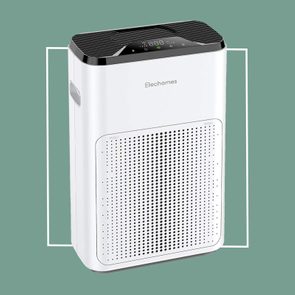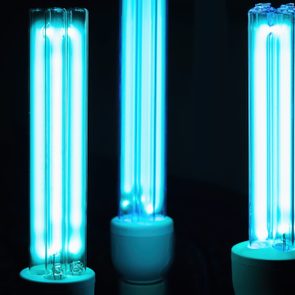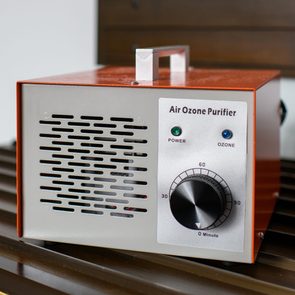7 Best Air Purifiers for Mold, According to Experts
Updated: Mar. 17, 2022
Reduce mold in your home for better respiratory health. These air purifiers for mold meet our experts' standards for quality.
Our editors and experts handpick every product we feature. We may earn a commission from your purchases.
A growing mold problem
Of all the indoor allergens lurking around your home, mold has to be one of the creepiest. Even worse? Research estimates that as many as 24 percent of U.S. homes may contain mold. (Here’s how your messy house is making you sick.)
The danger of mold in your home
Despite its widespread nature, mold can be a threat for a number of reasons. “As an indoor and outdoor allergen, mold has been implicated in causing many respiratory diseases, from basic seasonal allergies to serious pulmonary conditions, bronchitis, snoring, asthma, and sinusitis,” explains Neeta Ogden, MD, American Board of Allergy and Immunology–certified adult and pediatric allergist in Edison, New Jersey. “For this reason, it’s very important to minimize one’s exposure to mold, especially in the home, especially if it is a known trigger for one’s allergies and asthma.”
(Here are the scary effects of air pollution.)
Signs of mold
There’s not much you can do once mold has grown in your home aside from removing it physically. For instance, if you notice any blackening in the tile grout of your bath or shower, you can use a dilution of bleach, baking soda, and vinegar to kill the mold. “It’s best to do this with a mask to prevent inhalation of both spores and irritant chemicals,” Dr. Ogden adds.
How to prevent mold
The key to avoiding mold-related health issues is to prevent the stuff from growing in the first place. One of the ways Dr. Ogden recommends doing this is by reducing moisture levels in the home. “This means fixing and preventing any leaks, areas of pooling water, and excessive moisture and humidity—think that classic moldy basement,” she says.
In addition to not running your shower for long periods of time before getting in, she recommends wiping down surfaces often, as these are central areas of mold production.
(These are the best air-cleaning plants to detoxify your home, according to NASA.)
How a mold air purifier can help
Air filtering devices known as air purifiers can help detect and prevent it from growing in the first place. “In addition to growing on surfaces, mold also grows by releasing mold spores into the air,” explains Dr. Ogden. “This is where an air purifier can be helpful, as it keeps those invisible mold spores from circulating and landing on other services.”
An air purifier essentially pushes air through a filter or series of filters that capture up to 99.7 percent of particles and select allergens, explains Clifford Bassett, MD, founder and medical director of Allergy and Asthma Care of New York and author of The New Allergy Solution: Supercharge Resistance, Slash Medication, Stop Suffering.
(Here’s how to tell who needs an air purifier.)
What to look for in a mold air purifier
Here’s what experts recommend looking for in an air purifier for the purpose of detecting and preventing mold.
HEPA filter
Air purifiers with high-efficiency particulate air (HEPA) filters may be effective in trapping some mold spores, says Dr. Bassett. These work by mechanically filtering the air through a fine mesh material, which the Environmental Protection Agency (EPA) says can remove at least 99.97 percent of small, harmful air particles, including mold. The efficiency of HEPA air filters can depend on the various specifications of the air purifier, notes Dr. Bassett.
He recommends selecting a model based on your room size and dimensions to ensure that the air purifier is powerful enough to clean the volume of air in a room. “Actual performance can also depend on how frequently the HEPA filter is changed and how airtight the filter frame is,” he says. “Any gaps will allow mold spores through.”
UV light
Ultraviolet-C (UVC) light is considered a disinfectant for air, water, and nonporous areas. It can destroy indoor biological pollutants, including some molds.
An air purifier with UVC light in addition to a HEPA filter will be your best bet to kill mold spores because mold, a fungus, is a live organism, according to Dr. Odgen. “This in addition to a HEPA filter can be a double whammy to mold, as a HEPA filter will capture 99.97 percent of particles passing through the air filter,” she says.
But she notes that evidence about whether UV light works is equivocal. “This is in part because people argue that mold would need sustained exposure to UV to actually be killed off and also because UV can emit ozone, which is a known respiratory irritant,” she says. (Here’s what you need to know about UV air purifiers.)
Certifications
You want to make sure that your air purifier is certified, ideally by Energy Star, which ensures that a product meets strict energy performance standards set out by the EPA. Another certification that is worth considering is from the Association of Home Appliance Manufacturers (AHAM), which provides the Clean Air Delivery Rate (CADR) of each purifier and advises on the most suitable size of the room for that purifier. It’s worth noting, however, that there is no current CADR rating for mold as there is for allergens like pollen, smoke, and dust.
(Here’s what to know about ozone air purifiers.)
The best air purifiers for mold
These air purifiers are best suited for getting rid of mold particles in your home.

Filtrete Room Air Purifier
$70
This powerful, smart air purifier does a lot of things at once and can be used with your cell phone to give you updates, including when you need to change the filter, explains Dr. Ogden. “It also actively lets you know about the air quality in your home and will turn on when it senses air particles,” she says. “If there’s a sudden burst of mold, maybe from a pet who played outdoors in damp leaves, for example, it will automatically start filtering the air.”
(Here are more ways to improve indoor air pollution at home.)

Honeywell HPA300 True HEPA Air Purifier
$226
Honeywell air purifiers come in several different sizes and price points, but one thing they all have in common is that they are masters at removing allergens and reducing 99.97 percent of mold spores, as well as bacteria and airborne viruses. “Some models come with a permanent washable filter and others have filters that need to be replaced after some time,” says allergist Payel Gupta, MD, a national spokesperson for the American Lung Association. This one has three air-cleaning levels, including a Turbo Clean, as well as a five-year warranty.

Germ Guardian Air Purifier
$310
The list of things this air purifier can’t do is much shorter than the list of the things it can, including filtering out 99.97 percent of harmful allergens, like mold spores, pet dander, pollen, and dust; killing airborne germs with its UVC light; and even reducing odors, thanks to an activated charcoal filter that removes pollutants from the air. For an air purifier, this one from Germ Guardian is quite functional, with a filter that requires replacement every six to eight months, three-speed performance settings, and timer functionality.

SilverOnyx Air Purifier
$145
You can see by the ratings that this air purifier from SilverOnyx is doing something right. It’s particularly effective in large spaces and works to capture 99.97 percent of particles as small as 0.3 microns, including dust, mold, mildew, and viruses. It has a five-stage filtration process that effectively cleans the air to a high capacity through the use of a HEPA H13 activated carbon filter plus a UV light. If you have a pet, or your home is prone to odors, this air purifier can help reduce the smell.

Winix 5300-2 Air Purifier with True HEPA Filter
$141
Thanks to its true HEPA filter, this air purifier from Winix works to capture 99.97 percent of airborne pollutants, including mold particles as small as 0.3 microns. It utilizes a three-stage cleaning system that functions on several different modes, including sleep. It also features air-cleaning technology that neutralizes bacteria and viruses and an activated carbon filter that cuts back on volatile organic compounds (VOCs) as well as household odors.
(These are the household items poisoning your air.)

Airthereal APH260 Air Purifier
$110
With an impressive seven-in-one air filtration system, this air purifier from Airthereal is ready to squash any mold spores that come into the room it’s protecting. It removes 99.97 percent of fine particles as small as 0.3 microns and is equipped with both a fine-particulate matter (PM 2.5) sensor and air-quality indicator to provide you with the most up-to-date information regarding the air quality in your room.
In addition to its HEPA and activated carbon filters, it has a UVC light filter that provides an even deeper level of air sanitation. It is both CADR- and Electrical Testing Labs-certified, so you know it is held to the highest industry standards.

Pure Enrichment PureZone Elite 4-In-1 Air Purifier
$150
With four stages of purification, this air purifier from Pure Enrichment works to clean and sanitize the air in your room from 99.97 percent of allergens, including mold, dust, pollen, smoke, and bacteria. Stage 1 utilizes an activated carbon prefilter; stage 2 uses a HEPA filter; stage 3 utilizes a UVC light and photocatalyst filter; and stage 4 ionizes, or emits negative ions in the air to clean it. This air purifier is ideal for someone looking to stay energy efficient, as it features three automatic timer settings and allows you to choose one of three speeds for the fan.
(This is how your house is making you sick.)
















